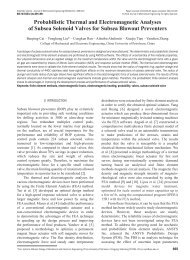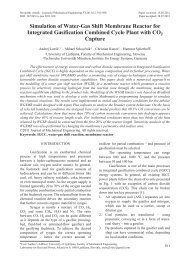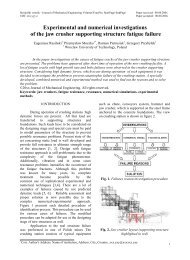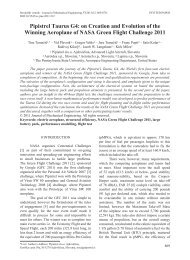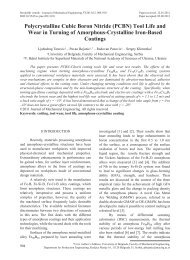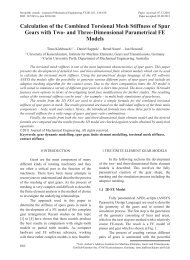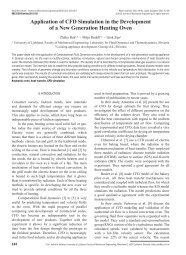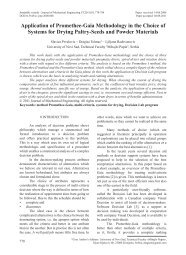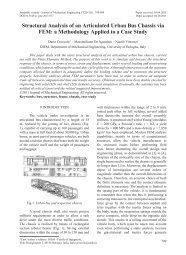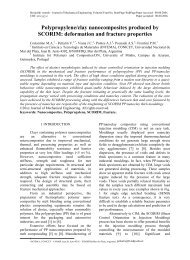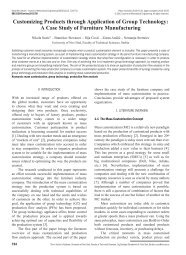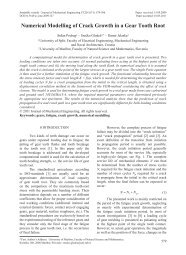Computation of Stress Intensity Factor in Functionally Graded Plates ...
Computation of Stress Intensity Factor in Functionally Graded Plates ...
Computation of Stress Intensity Factor in Functionally Graded Plates ...
You also want an ePaper? Increase the reach of your titles
YUMPU automatically turns print PDFs into web optimized ePapers that Google loves.
Strojniški vestnik - Journal <strong>of</strong> Mechanical Eng<strong>in</strong>eer<strong>in</strong>g 57(2011)7-8, 622-6324. Comparison <strong>of</strong> the obta<strong>in</strong>ed numerical resultswith the reference solutions <strong>in</strong>dicates thatboth energy-based EDI and direct approachDCT methods, <strong>in</strong> the framework <strong>of</strong> enrichedEFG, are efficient tools to analyze the thermalfracture <strong>of</strong> FGMs.7 REFERENCESFig. 15. Normalized mode I stress <strong>in</strong>tensity factor<strong>in</strong> the FGP versus normalized time and differentcrack lengths <strong>in</strong> plane stra<strong>in</strong> conditionFig. 15 depicts the transient thermal SIFversus normalized crack lengths a/W for planestra<strong>in</strong> case. Although the steady value <strong>of</strong> SIF isgreater for longer cracks, the peak value <strong>of</strong> SIF issignificantly large for short cracks.6 CONCLUSIONIn this paper, the doma<strong>in</strong> form <strong>of</strong> J-<strong>in</strong>tegral(EDI) and displacement correlation technique(DCT) <strong>in</strong> conjunction with element-free Galerk<strong>in</strong>method are implemented to evaluate the mode Istress <strong>in</strong>tensity factor <strong>in</strong> FGMs under steady-stateand transient temperature fields. The present studypo<strong>in</strong>ts out that:1. In the enriched EFG framework a relativelycoarse mesh <strong>in</strong> compared with FEM andcommon XFEM is sufficient for analysis <strong>of</strong>cracks <strong>in</strong> FGMs under thermal load<strong>in</strong>g.2. A short while after the thermal shock, SIF<strong>in</strong>creases to a large peak value, which issignificantly greater than the correspond<strong>in</strong>gsteady value and then decreases rapidly to asteady value. Moreover, although the crackis closed at steady state for some cases, thevalue <strong>of</strong> SIF might reach to a large positivevalue dur<strong>in</strong>g the thermal shock period. Theseimply that <strong>in</strong> thermal fracture analysis <strong>of</strong>FGMs, the SIF at the beg<strong>in</strong>n<strong>in</strong>g <strong>of</strong> thermalload<strong>in</strong>g might be the ma<strong>in</strong> factor <strong>in</strong> fracturefailure analysis.3. Parametric analyses <strong>in</strong>dicate that thevariation <strong>in</strong> the thermomechanical properties,especially thermal characteristics, hasa significantly <strong>in</strong>fluence on the fracturebehaviour <strong>of</strong> FGMs.[1] Kawasaki, A., Watanabe, R. (2002).Thermal fracture behavior <strong>of</strong> metal/ceramicfunctionally graded materials. Eng<strong>in</strong>eer<strong>in</strong>gFracture Mechanics, vol. 69, p. 1713-1728.[2] J<strong>in</strong>, Z-H., Noda, N. (1994). Crack-tip s<strong>in</strong>gularfields <strong>in</strong> nonhomogeneous materials. Journal<strong>of</strong> Applied Mechanics, Transactions ASME,vol. 61, p. 738-740.[3] Kishimoto, K., Aoki, S., Sakata, M.(1980). On the path <strong>in</strong>dependent J-<strong>in</strong>tegral.Eng<strong>in</strong>eer<strong>in</strong>g Fracture Mechanics, vol. 13, p.841-850.[4] Erdogan, F., Wu, B.H. (1996). Crackproblems <strong>in</strong> FGM layers under thermalstresses. Journal <strong>of</strong> Thermal <strong>Stress</strong>es, vol. 19,p. 237-265.[5] Noda, N., Guo, L.C. (2008). Thermal shockanalysis for a functionally graded plate witha surface crack. Acta Mechanica, vol. 195, p.157-166.[6] Yildirim, B. (2006). An equivalent doma<strong>in</strong><strong>in</strong>tegral method for fracture analysis <strong>of</strong>functionally graded materials under thermalstresses. Journal <strong>of</strong> Thermal <strong>Stress</strong>es, vol. 29,p. 371-397.[7] Dag, S. (2006). Thermal fracture analysis<strong>of</strong> orthotropic functionally graded materialsus<strong>in</strong>g an equivalent doma<strong>in</strong> <strong>in</strong>tegral approach.Eng<strong>in</strong>eer<strong>in</strong>g Fracture Mechanics, vol. 73, p.2802-2828.[8] KC, A., Kim, J.H. (2008). Interaction <strong>in</strong>tegralsfor thermal fracture <strong>of</strong> functionally gradedmaterials. Eng<strong>in</strong>eer<strong>in</strong>g Fracture Mechanics,vol. 75, p. 2542-2565.[9] Kim, J.H., KC, A. (2008). A Generalized<strong>in</strong>teraction <strong>in</strong>tegral method for the evaluation<strong>of</strong> the T-stress <strong>in</strong> orthotropic functionallygraded materials under thermal load<strong>in</strong>g.Journal <strong>of</strong> Applied Mechanics, vol. 75, p.1-11.<strong>Computation</strong> <strong>of</strong> <strong>Stress</strong> <strong>Intensity</strong> <strong>Factor</strong> <strong>in</strong> <strong>Functionally</strong> <strong>Graded</strong> <strong>Plates</strong> under Thermal Shock631



